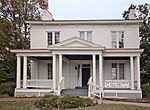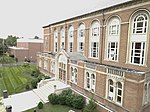Walnut Hills Cemetery (Cincinnati)
Cemeteries in CincinnatiCincinnati stubsGerman-American historyHamilton County, Ohio geography stubsUnited States cemetery stubs

Walnut Hills Cemetery is located at 3117 Victory Parkway in the Walnut Hills neighborhood of Cincinnati, Ohio. The cemetery opened in 1843, under the name of "The Second German Protestant Cemetery". Other names include "German Cemetery", "German Protestant Cemetery", and "Walnut Hills Protestant Cemetery". Its original size was about 5 acres (20,000 m2). In 1941, at the beginning of World War II, the name was changed to Walnut Hills Cemetery. Today, the cemetery sits on over 70 acres (280,000 m2). Major League Baseball player George Rohe (1874–1957) is buried there.
Excerpt from the Wikipedia article Walnut Hills Cemetery (Cincinnati) (License: CC BY-SA 3.0, Authors, Images).Walnut Hills Cemetery (Cincinnati)
Foraker Avenue, Cincinnati Walnut Hills
Geographical coordinates (GPS) Address Nearby Places Show on map
Geographical coordinates (GPS)
| Latitude | Longitude |
|---|---|
| N 39.134444444444 ° | E -84.481944444444 ° |
Address
Foraker Avenue
Foraker Avenue
45206 Cincinnati, Walnut Hills
Ohio, United States
Open on Google Maps









